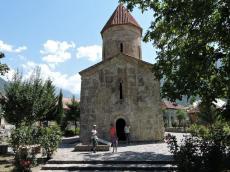|
|
TODAY.AZ / Society
Kish, mother of Alban churches turns into tourist hotspot
25 August 2017 [10:00] - TODAY.AZ

By Azernews
By Amina Nazarli
Once you travel to Azerbaijan be sure to visit Kish, one of the oldest villages located in the northwestern region Sheki.
The village roads are made of fluvial stone. That’s why it is recommended to wear comfortable shoes, and enjoy the majestic view. Here, fluvial stone is present everywhere. Streets, fences around the homes, and even houses are built of this beautiful stone.
The village is well known for its unique ancient Albanian temple - mother of Alban churches. This ancient monument of Azerbaijani-Albanian architecture is believed to be the oldest church in the Caucasus, founded in the 1st century by the Apostle Eliseus.
Researches show that the Kish church can be considered as one of the cradles of Christianity and embodies this country's ancient history and rich cultural heritage through the centuries.
For centuries, the church functioned as a spiritual center and place for enlightenment for people of the East.
The tiny village populated with some 6,000 inhabitants may not impress you at first glance. However, just walk the quiet cobble-stoned streets to the Kish church to see a captivated perspective against a background of lofty mountains.
A steep but manageable climb up to the church, beautiful quiet setting with some amazing views all around definitely deserves it.
This temple attracted famous Norwegian explorer and scientist Thor Heyerdahl in 2000. Study, restoration and conversion of the ancient church started the same year and finalized in 2003 jointly by Norway and Azerbaijan.
Nowadays, the church is functioning as a museum that is open for all the curious tourists. About 10,000 tourists from Russia, Spain, Italy, Germany and Arab countries visited the church just since early 2017, said Ilhama Huseynova, the Director of Kish Historical and Architectural Reserve.
The Kish Alban temple was included in the list of world-wide monuments by the decision of the Cabinet of Ministers of Azerbaijan dated August 2, 2001 and protected by the state as a historical and architectural monument. In 2003, the Historical-Architectural Reserve Museum was established in the area of the temple.













URL: http://www.today.az/news/society/164372.html
 Print version
Print version
Connect with us. Get latest news and updates.
See Also
- 09 November 2024 [20:06]
Azerbaijan Airlines launches direct flights to Maldives - 09 November 2024 [13:13]
15 routes temporarily suspended in Baku for COP29 - 06 November 2024 [17:50]
Azerbaijani carpet expert awarded in South Korea - 06 November 2024 [17:06]
Baku to host multimedia show dedicated to Mosfilm - 06 November 2024 [15:47]
Young Spectators Theater to present new solo performance - 06 November 2024 [14:07]
Don't miss opportunity to see Lorenzo Quinn's works at Heydar Aliyev Center - 05 November 2024 [15:37]
Agenda for COP29 Conference released - 05 November 2024 [11:53]
Baku hosts Global Summit of Religious Leaders - 04 November 2024 [17:38]
Azercell joins COP29 as event’s Official Telecom Partner - 04 November 2024 [15:49]
Quincy Jones dies at age of 92
Most Popular
 Azerbaijan's Leadership at COP29: Addressing Global Climate Challenges and Exposing Hypocrisy
Azerbaijan's Leadership at COP29: Addressing Global Climate Challenges and Exposing Hypocrisy
 Provocateur Le Pen go to jail
Provocateur Le Pen go to jail
 Macron Stung by President Ilham Aliyev's Truth: French Minister Ordered to Skip Baku Visit
Macron Stung by President Ilham Aliyev's Truth: French Minister Ordered to Skip Baku Visit
 Who uses Greta Thunberg and how?
Who uses Greta Thunberg and how?
 Climate Platform for business, investment & philanthropy launched within COP29
Climate Platform for business, investment & philanthropy launched within COP29
 United States announced plans to deepen security cooperation with Indonesia
United States announced plans to deepen security cooperation with Indonesia
 Azerbaijan’s COP29 presidency sets precedent with focus on amplifying voices of vulnerable nations
Azerbaijan’s COP29 presidency sets precedent with focus on amplifying voices of vulnerable nations
